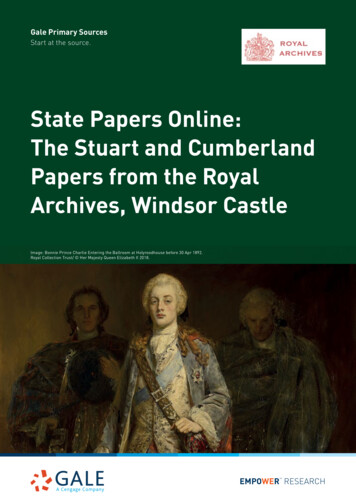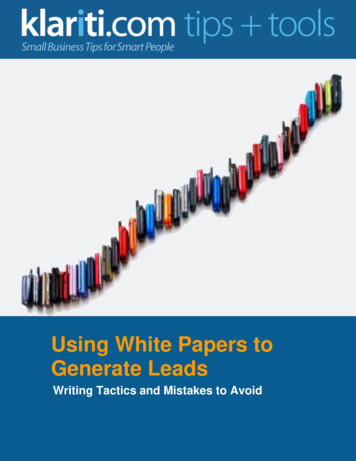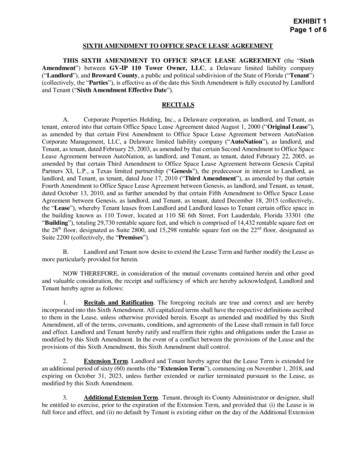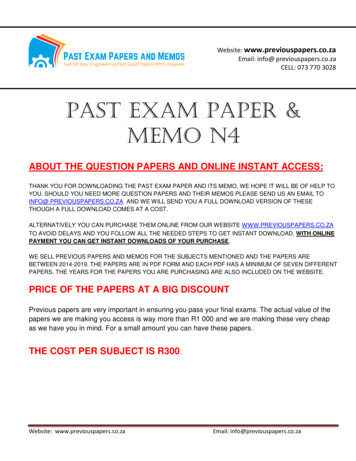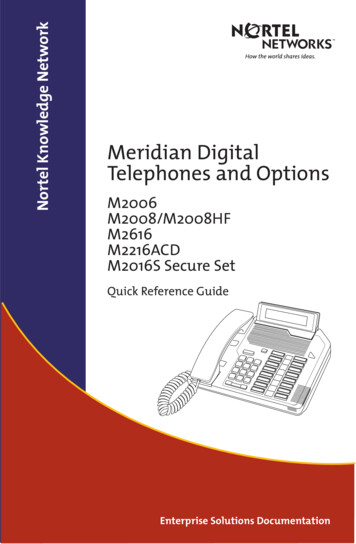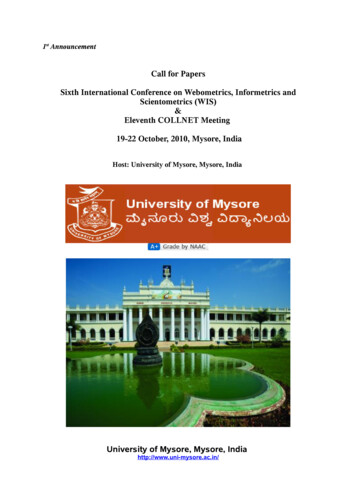
Transcription
1st AnnouncementCall for PapersSixth International Conference on Webometrics, Informetrics andScientometrics (WIS)&Eleventh COLLNET Meeting19-22 October, 2010, Mysore, IndiaHost: University of Mysore, Mysore, IndiaUniversity of Mysore, Mysore, Indiahttp://www.uni-mysore.ac.in/
UNIVERSITY OF MYSOREThe University of Mysore is among the foremost institutions of its kind, and is anenduring symbol in the sphere of higher education in India. It was founded by the thenMaharaja of Mysore, His Highness Sri Krishnaraja Wodeyar IV and his Dewan, the renownedengineer - statesman, Sir M. Visvesvaraya, on July 27, 1916. The Maharaja of Mysore becameits first Chancellor. A Bill to establish and incorporate the University was introduced inMysore Legislative Council in 1916. It was passed unanimously on 17th July 1916. The firstmeeting of the University Council was held on 12th August 1916 and the first meeting of theSenate on 12th October 1916.The University of Mysore became the first University outside the domain of theEnglish administration in India, the sixth University in India as a whole, and the first everUniversity in Karnataka. During the institution of the University in 1916, four faculties wereconstituted viz., Arts, Science, Engineering and Technology, and Medicine. Separate Boardsof Studies and Boards of Examiners were constituted in 28 subjects. The University was alsoadministering 12 other educational institutions.The first Act of the University came in the year 1933 (University of Mysore Act1933). The first report of the curriculum followed by different departments is available in theUniversity's Calendar 1947-48. The University offered a two-year intermediate Course, threeyear B.A. (Hons), B.Sc.,(Hons) Degree Courses and M.A., M. Sc., Courses. There were alsothe faculties of Medicine and Engineering. The University also offered Diplomas invocational subjects. The University Extension Lectures and Publication Bureau were notablefeatures of the University.The main campus of the University, created in 1960, lies in a picturesque area of 739acres at the western end of the Kukkarahalli Lake. The University headquarters, the CrawfordHall, is located right across the lake on the eastern end. This inspiring locale of the campus
was aptly named Manasagangotri (Fountainhead of the Ganges of the Mind) by the poetlaureate, Dr. K. V. Puttappa (Kuvempu). In due course, two satellite campuses were set up inresponse to the demands of post graduate education from semi-urban/rural areas: Sir M.Visvesvaraya Post Graduate Centre at Tubinakere in Mandya, and the Mysore University Postgraduate Centre at Hemagangotri in Hassan.In the beginning, the entire Princely State of Mysore comprising of nine districts cameunder the jurisdiction of the University. Now it is confined to Mysore, Mandya, Hassan, andChamarajanagar districts. The remaining areas come under the Bangalore University (1964),Mangalore University (1980), and Kuvempu University (1987). The institution, incidentally,gave birth to one more University in 1996 when the Institute for Correspondence Courses andContinuing Education in the Manasagangotri campus, got transformed into the KarnatakaState Open University.The University now encompasses 122 affiliated colleges and 5 Constituent Colleges(with an aggregate of 53,000 students). In addition, the University has 37 post graduatedepartments, 8 specialised research & training centres and 2 post graduate centres thattogether offer about 55 regular academic programmes to 3,500 students. It also runs a numberof employment-oriented diploma courses and certificate programmes. The post graduatedepartments are reputed for excellence in advanced studies and research, and have attractedprojects and grants worth crores of rupees from many national and international institutions.The University has developed excellent infrastructure for curricular and co-curricularactivities. The Mysore University Library offers a collection of over 8 lakh books, 2,400journal titles and 1 lakh volumes of journals. The main campus features an amphitheatre, anauditorium, a swimming pool, and hostels for women and men with modern amenities andcomforts.The University has established a rapport with many well-known and prestigiousuniversities and institutions abroad for academic, technical and cultural exchange.Having served the cause of higher education and research with distinction anddedication for almost the whole of the 20th century, the University of Mysore now envisages
the 21st century as an era of even greater growth and success during which it will producewell-qualified and well-motivated youth to serve humanity as teachers, administrators,doctors, engineers, scientists, lawyers, social workers and in various other fields. As it getscloser to its centenary celebrations, the University looks forward to newer ways of fulfillingthe vision of its Founding Fathers.ScopeQuantitative aspects of science of science. Collaboration and communication in science and intechnology. Science policy. Combination and integration of qualitative and quantitativeapproaches.Theoretical, methodological and applied aspects, for example:- Emerging issues in Scientometrics / Informetrics /webometrics and history- Science Policy and collaboration- Collaboration Studies for Science & Society- Collaboration, Knowledge Management & Industrial Partnership- Collaborative Bridge between Academic Research and Industry- Techniques for Collaboration Studies- Visualization Techniques in Collaboration Studies- Quantitative analysis of S&T innovations- Informetrics laws and distributions, mathematical models of communication orcollaboration- Nature and growth of science and of collaboration in science and its relation withtechnological output- Evaluation indicators- Collaboration in science and in technology from both quantitative and qualitativepoints of viewPlease, note that these examples listed above give a broad outline of the scope of theworkshop theme but do not limit it.COLLNET and ISSICOLLNET is a global interdisciplinary research network of scholars who are concerned tostudy aspects of collaboration in science and in technology (see COLLNET web site at:http://www.collnet.de/). This network of interdisciplinary scholars was established in January2000 in Berlin with Hildrun Kretschmer as coordinator. Since that time there have been 9meetings: the first in Berlin, September 2000, the 2 nd in New Delhi, February 2001 and the 3rdin Sydney (in association with the 8th ISSI Conference), July 2001. The former ISSI PresidentMari Davis has mentioned in the Newsletter, July 2003: Importantly, ISSI needs alliance withother groups, such as COLLNET, for broader reach among a range of interdisciplinaryresearchers and to encourage new thinking and perspectives on investigations in science andin technology. The 4th COLLNET Meeting took place on August 29th in 2003 in Beijing inconjunction with the 9th International ISSI Conference; the International Workshop onWebometrics, Informetrics and Scientometrics and 5th COLLNET Meeting in Roorkee, India,in March 2004. The 6th COLLNET Meeting took place in association with the 10 th ISSIConference in Stockholm, Sweden, in July 2005 and the International Workshop onWebometrics, Informetrics and Scientometrics and 7th COLLNET Meeting in Nancy, France,in May 2006. The Third International Conference on Webometrics, Informetrics,Scientometrics and Science and Society & Eighth COLLNET Meeting took place in NewDelhi, India, in March 2007 (http://www.collnet-delhi.de) , the Fourth InternationalConference on Webometrics, Informetrics and Scientometrics & Ninth COLLNET Meeting inBerlin, Germany in July 2008 (http://www.collnet-berlin.de) and the Fifth International
Conference on Webometrics, Informetrics and Scientometrics & Tenth COLLNET Meeting inDalian, China, in September 2009 (http://www.wiselab.cn/collnet-dalianProgram Chair:Hildrun Kretschmer (Germany, China)Program Co- Chair: S.L. Sangam (India)Organising Chair:V.G.Talwar, Vice Chancellor, Mysore (India)Programme Committee:COLLNET Membershttp://www.collnet.de/Conference Fee:- Foreign Participants: 100 Euro- Foreign Students: 50 Euro- Foreign Accompanying persons: 50 Euro- Indian participants: RS.2500/- Indian students: Rs.500The fee includes coffee break, lunches, Inaugural Cocktail, dinner and banquet.Proceedings are included in the conference fee for participants and students but not foraccompanying persons.The sightseeing tour of Mysore is included in the conference fee.For persons who are interested in, a special extended tour will be programmed at the last day(with additional fees).For more information please contact: Mallinath Kumbarmallinathk@yahoo.comImportant Dates:Extended Abstract (3 pages):April 15, 2010 (deadline)Acceptance: May 15, 2010Full Paper: August 15, 2010 (deadline)(Camera-ready version, maximum 10 pages including tables, figures, references)Both abstracts and full papers will be peer reviewed by the Programme Committee. Theaccepted full papers will be published in the proceedings.Please send your extended abstracts to:Hildrun KretschmerKretschmer.h@onlinehome.dePlease send also a copy to:S. L. Sangamslsangam@yahoo.com
UNIVERSITY OF MYSORE The University of Mysore is among the foremost institutions of its kind, and is an enduring symbol in the sphere of higher education in India. It was founded by the then Maharaja of Mysore, His Highness Sri Krishnaraja Wodeyar IV and his Dewan, the renowned







